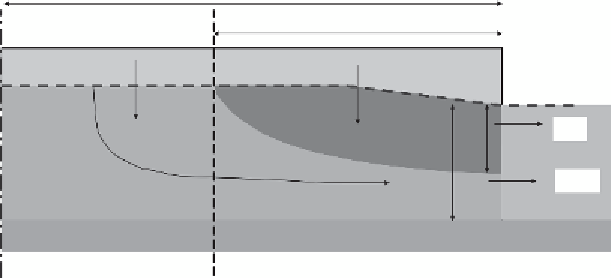Geoscience Reference
In-Depth Information
4
3
Soil surface
c
in
c
in
Canal
1
C
in
2
C
= 0
x
=
L
/2
x
=
x
x
=
0
Figure 5.16
Adopted streamline pattern to determine the mean concentration of soil
water lowing into the canals.
5.10 Simulation of Solute Transport
Various analytical solutions of solute transport in unsaturated and saturated soil exist, as
shown in this chapter. However, most of the analytical solutions require a homogeneous
soil, steady-state conditions and linear reaction coeficients. In ield soils we deal with
heterogeneous soils, rapidly changing conditions and nonlinear reactions. Numerical
simulation models of water and solute transport as HYDRUS (Šimůnek,
1998a
) and
SWAP (
Chapter 9
) take these ield conditions into account. Also, numerical models
may solve the general water low equation (
Chapter 4
) and solute transport equation
(this chapter) simultaneously, which allows to examine all kind of interactions between
water low, solute transport and crop growth. Examples are the effect of salinity on root
water uptake and crop growth and the effect of crop growth on evapotranspiration.
An extensive study on pesticide leaching in heterogeneous ield soils has been
performed by Groen (
1997
). Field data were collected at experimental, drained ields
with soil textures loamy sand and cracked clay, and cultivation of tulips, potatoes and
fruits. Four commonly used pesticides were applied, together with the tracer bro-
mide. The laboratory measurements included for each soil layer the hydraulic func-
tions, the adsorption isotherm and the decomposition as function of temperature. The
ield measurements for model input included rainfall, reference evapotranspiration
and drainage rates as function of groundwater level. In addition ield measurements
were conducted for model calibration and validation. These measurements consisted
of periodic water contents and bromide/pesticide concentrations in the soil proile
and in the drainage water. After calibration, the SWAP model was used to formulate
design and management criteria to decrease pesticide leaching. The amount of leach-
ing turned out to depend mainly on application time, weather conditions, preferential
low and pesticide absorption and decomposition.

Search WWH ::

Custom Search